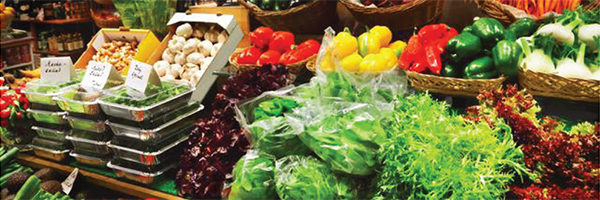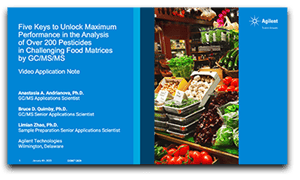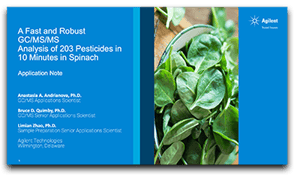
Overview
The global agriculture industry uses over a thousand different pesticides in the production of food. Pesticides are required for producers to meet the increasing demand for reasonably priced food. This growing need has led to an increased use of pesticides and encourages problematic agricultural practices that have elevated risks in the food supply and the environment. Concerns about trace level chemical pollutants in food are driving the demand for more rapid and reliable methods for the identification and quantitation of chemical residues. These two video presentations show two recent developments and applications of pesticide analysis using novel Agilent 7000E and 7010C triple quadrupole GC/MS systems.
What's included?
Video Applications

Five Keys to Unlock Maximum Performance in the Analysis of Over 200 Pesticides in Challenging Food Matrices by GC/MS/MS
This application note described five best practices in sample preparation and how the Agilent 8890/7000E and 8890/7010C triple quadrupole GC/MS systems' analysis applied to 203 pesticides in challenging food matrices, including spinach, walnut, and cayenne pepper. Calibration performance was demonstrated over a wide dynamic range to over four orders of magnitude. It was shown that the Agilent 8890/7000E triple quadrupole GC/MS system achieved excellent linearity over a concentration range of 0.1 to 5,000 ppb. The Agilent 8890/7010C triple quadrupole GC/MS system demonstrated superior sensitivity yielding a higher signal-to-noise ratio at lower concentrations.
Duration: 20 minutes

A Fast and Robust GC/MS/MS Analysis of 203 Pesticides in 10 Minutes in Spinach
There is a growing demand for more rapid methods for the identification and quantitation of chemical residues in food analysis without sacrificing method robustness and chromatographic performance. This application note focuses on demonstrating two fast GC/MS/MS methods using (a) the Agilent 8890 GC and 7000E triple quadrupole GC/MS system and (b) the Agilent 8890 GC and 7010C triple quadrupole GC/MS system. The presented methods provide a shortened run time of 10 minutes, while maintaining robust system performance in the challenging spinach extract, without loss in sensitivity or method performance.
Duration: 15 minutes
Presenter: Anastasia Andrianova
Anastasia Andrianova
GC/MS Applications Scientist,
Agilent Technologies
Dr. Anastasia Andrianova is a GC/MS Applications Scientist in the Mass Spectrometry Division of Agilent Technologies, located in Wilmington, Delaware, USA. She is currently working in GC/MS applications in multiple areas including environmental and food safety.
Plus download the application notes
In addition to the video applications you will also be able to download your personal copies of the associated application notes, and a selection of related assets and links.
 Five Keys to Unlock Maximum Performance in the Analysis of Over 200 Pesticides in Challenging Food Matrices by GC/MS/MS
Five Keys to Unlock Maximum Performance in the Analysis of Over 200 Pesticides in Challenging Food Matrices by GC/MS/MS
This application note describes five best practices in sample preparation and how the Agilent 8890/7000E and 8890/7010C triple quadrupole GC/MS systems' analysis applied to 203 pesticides in challenging food matrices, including spinach, walnut, and cayenne pepper.
 A Fast and Robust GC/MS/MS Analysis of 203 Pesticides in 10 Minutes in Spinach
A Fast and Robust GC/MS/MS Analysis of 203 Pesticides in 10 Minutes in Spinach
This application note describes two GC/TQ system configurations using mid-column backflush that both enable robust pesticide analysis in 10 minutes, while maintaining sufficient chromatographic resolution for 203 compounds.
Sponsor:

